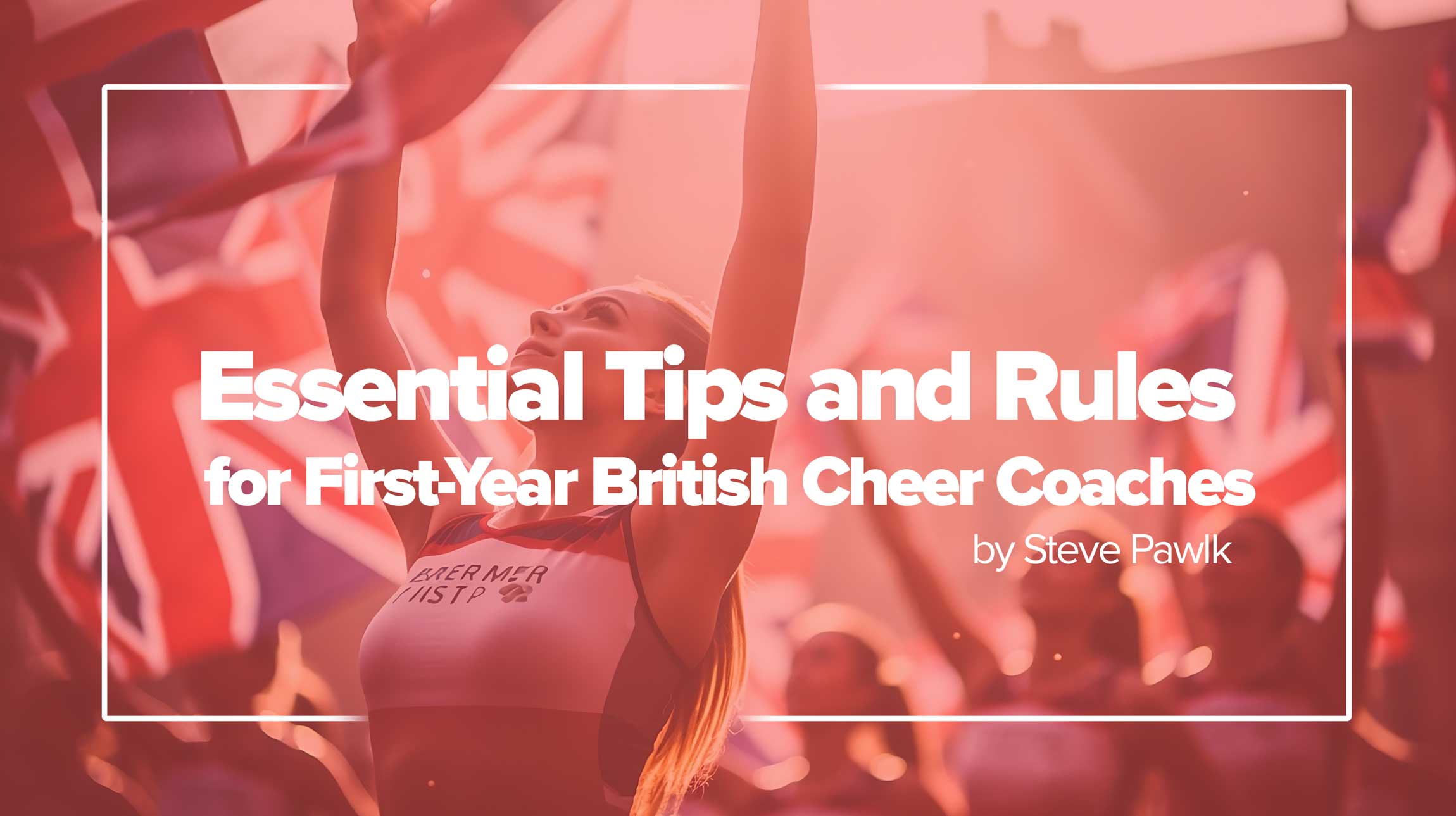By Steve Pawlyk
Published January 15, 2025
Cheerleading evolves every year, as governing bodies like the U.S. All Star Federation (USASF) and National Federation of State High School Associations (NFHS) refine rules to increase safety, fairness, and overall spectacle. While these updates may seem daunting at first, they can actually open doors for fresh choreography, innovative stunts, and advanced crowd engagement—if you know how to adapt. In this article, we’ll break down the most important rule changes you need to understand before your team takes the mat this season.
1. Stunting & Pyramids
What’s Changed?
- Height & Inversion Restrictions: Certain levels now face tighter guidelines on how high flyers can go in extended stunts and how many inversions are allowed. This is largely to ensure the difficulty remains age-appropriate and to prioritize athlete safety.
- New Spotter Requirements: Some divisions may mandate additional spotters for high-risk transitions (especially inversions and twisting mounts). Coaches must be aware of how many spotters are needed and in what positions.
Why It Matters
- Minimizing Injuries: Stricter rules encourage safer stunts, reducing the risk of falls and associated injuries.
- Routine Adaptations: If you’ve been using complex stunts, you may need to rework parts of your routine to fit new guidelines—particularly in levels where advanced inversions are limited
Practical Example
- Level 3 Inversions: Suppose your team relies on a forward roll from a prep-level stunt into a load-in. Check if updated rules still allow this inversion at your team’s level or if a spotter is now explicitly required.
2. Tumbling & Passes
What’s Changed?
- Revised Skill Allowances: Each level has a specific range of permitted tumbling skills, such as back handsprings, tucks, and fulls. Some new rule sets might restrict (or expand) certain passes.
- Focus on Progressions: Certain levels are emphasizing clear skill progressions—e.g., you cannot perform a front tuck if your team hasn’t demonstrated mastery of simpler skills.
Why It Matters
- Score Sheet Implications: If a once-legal pass is now restricted, performing it may result in deductions. Conversely, if a skill was introduced into your allowed level, you can incorporate it to gain difficulty points.
- Safety & Development: Encouraging coaches to stick to structured progressions helps prevent injuries and ensures athletes develop strong fundamentals.
Practical Example
- No Jump Directly into Tuck: At some levels, new rules might prohibit jumping directly from a toe touch into a back tuck. This means your choreography must pivot to separate jumps from standing tucks.
3. Music & Voice-Over Edits
What’s Changed?
- Music Licensing: Rule updates often include clarifications on using licensed music versus royalty-free or custom mixes. Competitions may require proof of proper licensing to avoid disqualification.
- Voice-Over Restrictions: Some leagues now have guidelines on how many voice-overs or sound effects can be used, preventing routines from becoming too cluttered with audio snippets.
Why It Matters
- Legal Compliance: Failing to adhere to licensing requirements can result in major deductions or disqualification.
- Routine Flow: With voice-over restrictions, coaches must be strategic. Instead of multiple quick phrases, consider fewer but more impactful voice-overs that guide transitions or highlight big stunts.
Practical Example
- Custom Mix Adjustments: If you rely heavily on pop songs in your routine, you may need to work with a recognized music producer who can ensure the mix is licensed and meet competition guidelines.
4. Division & Age Grid Adjustments
What’s Changed?
- Age Grid Shifts: The minimum or maximum ages for certain divisions may have been altered, affecting team rosters.
- Coed vs. All-Girl Splits: Some organizations tweak the thresholds for coed divisions based on the number of male athletes. Double-check your division if you’re near the cutoff.
Why It Matters
- Roster Planning: Even a small age-grid change can disqualify an athlete from a division, forcing you to reshuffle.
- Team Composition: If you have male athletes, a shift in the coed rules can move you to a completely different competitive bracket.
Practical Example
- 12 vs. 13 Age Requirement: If your junior athlete recently turned 13 and the division cutoff changed to 12, that athlete might need to move up to the next level or division earlier than you planned.
5. Safety Clarifications & Penalties
What’s Changed?
- Spotter Positioning: Some recent clarifications detail exactly where a spotter must stand for certain stunts, and how actively they must engage with the stunt group.
- Uniform & Equipment Rules: Updated guidelines may specify new restrictions on jewelry, nails, or hair accessories to reduce potential hazards.
- Deductions for Unintentional Contact: If a flyer or base collides with another group on the mat, even unintentionally, more competitions are now imposing severity-based deductions.
Why It Matters
- Fewer Surprises: Knowing these clarifications helps you avoid unexpected penalties.
- Consistency Across Events: Many competition hosts adopt these clarifications to unify safety standards.
Practical Example
- Disallowed Hair Accessory: A bow with stiff or metallic parts might violate new safety criteria. The result could be a penalty or an immediate request to remove the accessory.
6. Scoring Emphasis on Execution
What’s Changed?
- Technical Execution Weight: Across multiple competition brands, the percentage of your overall score for technique and synchronization might have increased.
- Difficulty vs. Execution Balance: While difficulty remains key, a sloppy advanced skill might score lower than a clean intermediate skill.
Why It Matters
- Coaching Focus: Coaches should spend more time perfecting timing, lines, and transitions.
- Routine Strategy: Instead of squeezing in the hardest possible stunts, emphasize cleaner, well-executed elements for a more reliable score.
Practical Example
- Double Down Deductions: If your team includes a double down from an extended stunt but consistently lands with bent knees or off counts, you’re better off sticking with a single down done perfectly.
How to Stay Ahead of Rule Changes
- Subscribe to Official Updates
- Follow USASF, NFHS, and any regional competition circuit newsletters or social media.
- Attend Coaches’ Conferences
- Many organizations host rule interpretation sessions—take advantage of these to ask questions and get clarifications.
- Leverage Experienced Choreographers
- Professional choreographers often keep up with rule shifts. Collaborating with them ensures your routine meets the latest guidelines.
- Communicate with Parents & Athletes
- If an athlete ages out of a division, or a new stunt is disallowed, inform everyone promptly to manage expectations.
Rule changes can feel overwhelming, but they’re ultimately designed to keep athletes safe and encourage continuous advancement in cheerleading. By staying informed, making proactive adjustments, and emphasizing clean execution, your team can transform new regulations into opportunities for growth—and deliver a winning routine that wows both judges and crowds.
IPP's Premade Mixes are USA Cheer Compliant and customizable! Add Sound FX, swap songs, & more! Add your Team Name to the mix for only $10!




















